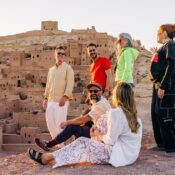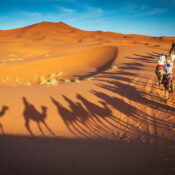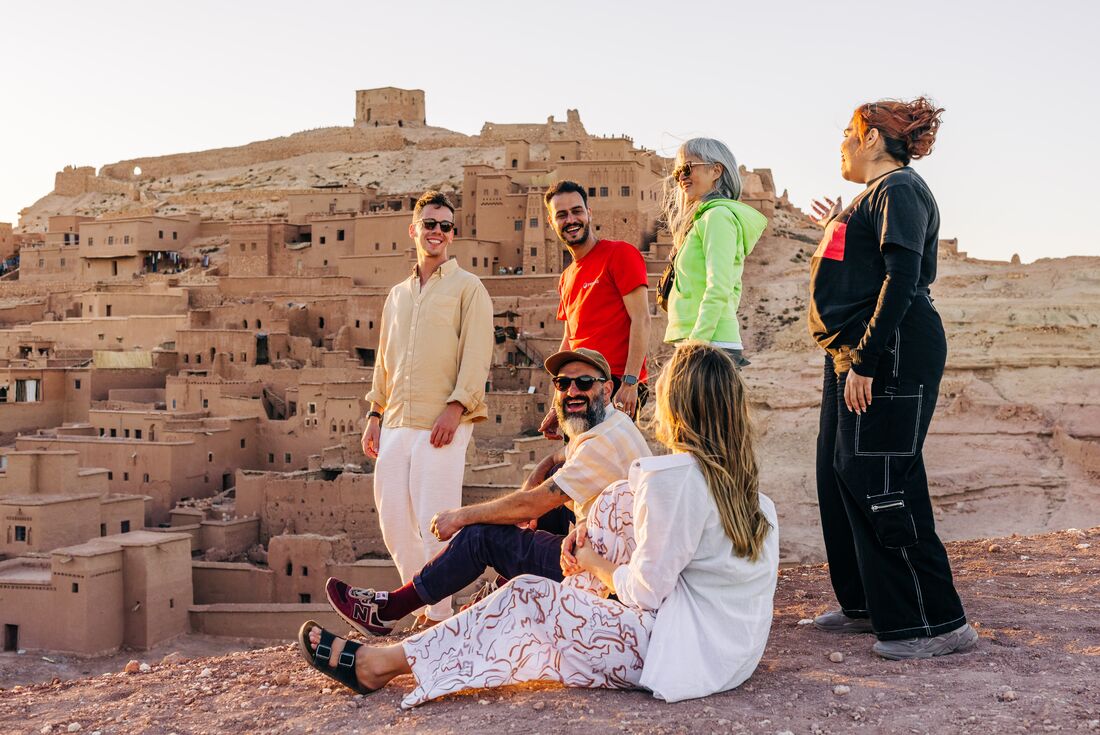
10 Must-visit destinations in Morocco
Introduction
When it comes to destinations that captivate with their exotic allure, Morocco stands out as a true gem. This North African country is a mosaic of rich history, diverse culture, and breathtaking landscapes. From the bustling medinas to the tranquil deserts, Morocco offers a unique experience for every traveler. Here are ten must-visit destinations that will make your Moroccan adventure unforgettable. With its blend of ancient traditions and modern allure, Morocco promises a journey that will leave you enchanted and longing for more.
Marrakech – the red city
Jemaa el-Fnaa

No visit to Marrakech is complete without experiencing Jemaa el-Fnaa, the heart of the city. This bustling square is a vibrant mix of food stalls, entertainers, and artisans. By day, it’s a lively market, but by night, it transforms into a magical open-air theater. Street performers, storytellers, and musicians create an unforgettable atmosphere, while the aroma of exotic spices and grilled meats fills the air. Whether you’re sampling local delicacies or simply soaking in the sights and sounds, Jemaa el-Fnaa offers an authentic taste of Moroccan culture.
Majorelle garden
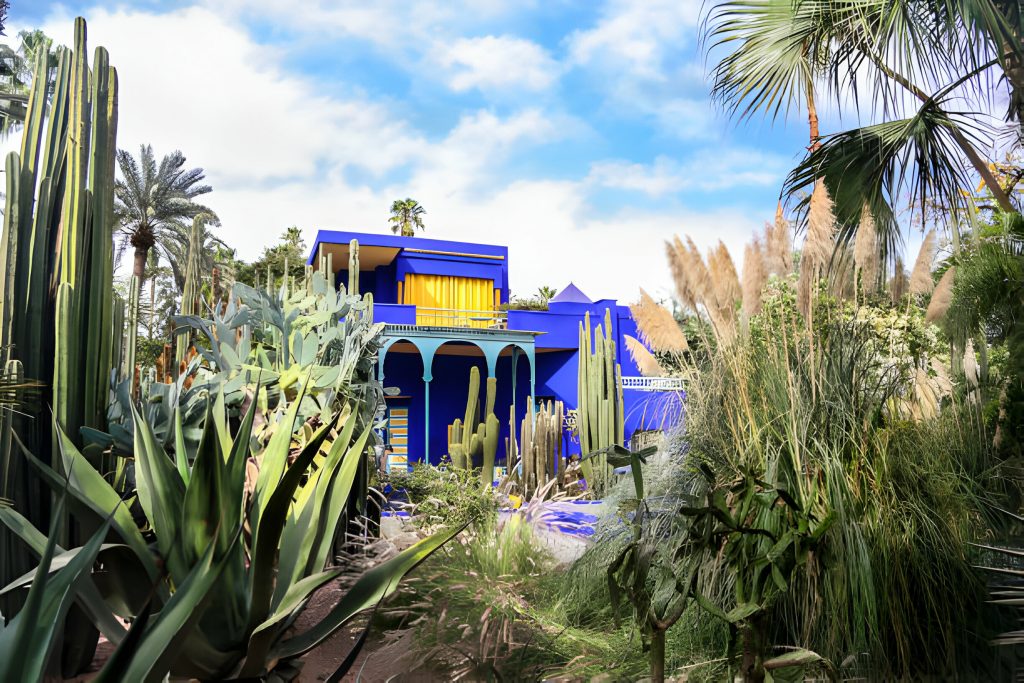
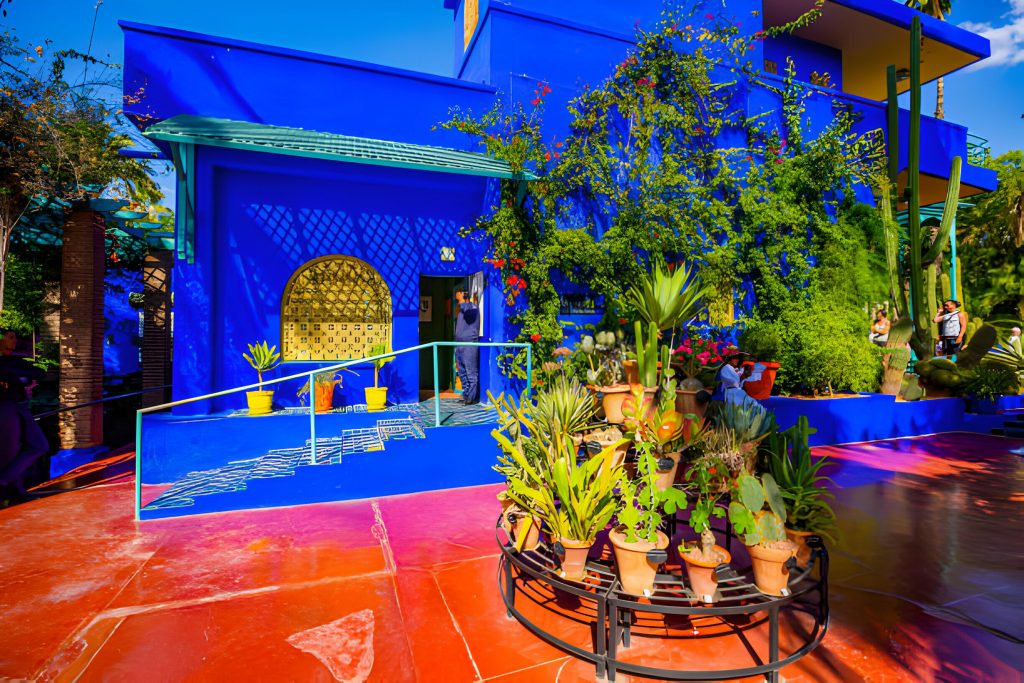
Escape the hustle and bustle of the medina in the serene Majorelle Garden. This beautiful oasis, created by French painter Jacques Majorelle and later restored by fashion designer Yves Saint Laurent, is filled with exotic plants, fountains, and vibrant blue buildings. The garden provides a peaceful retreat where visitors can stroll among towering bamboo, cacti, and bougainvillea. The contrasting colors and tranquil ambiance make it a favorite spot for photographers and nature lovers alike, offering a unique blend of art and horticulture.
Saadian tombs

The Saadian Tombs, hidden for centuries and rediscovered in 1917, offer a glimpse into Morocco’s opulent past. The intricate carvings and beautiful gardens make it a must-see historical site. Located in the Kasbah district, these tombs date back to the reign of Sultan Ahmad al-Mansur in the late 16th century. The site includes the main mausoleum with its stunningly detailed woodwork and stucco, as well as numerous graves of Saadian royalty and soldiers. Visiting the Saadian Tombs provides a fascinating insight into the grandeur and history of the Saadian dynasty.
Fes – the ancient city
Al Quaraouiyine University
Considered the oldest university in the world, Al Quaraouiyine University in Fes is a marvel of Islamic architecture and scholarship. Founded in 859 AD, it remains a significant cultural and educational landmark. The university complex includes a mosque, a library, and several educational buildings, all featuring exquisite tilework, intricate carvings, and impressive arches. As a center of learning for over a millennium, Al Quaraouiyine continues to inspire with its rich intellectual and architectural heritage, symbolizing the enduring legacy of Islamic education.
Chouara tannery
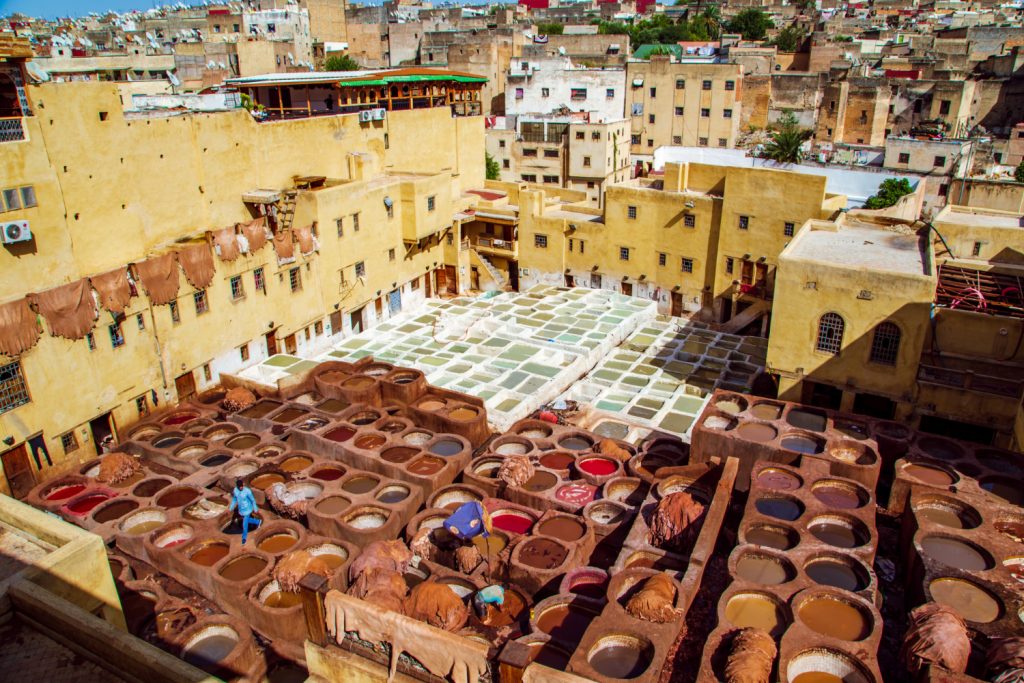
Witness the traditional art of leather tanning at the Chouara Tannery. The sight of colorful dye vats and the smell of leather create an unforgettable sensory experience. Located in the heart of Fes’ medina, this tannery has been operating since medieval times, using techniques that have remained largely unchanged. Visitors can observe the process from nearby terraces, watching as workers treat and dye hides in a variety of vibrant colors. It’s a unique glimpse into one of Morocco’s oldest crafts, offering a fascinating blend of tradition and craftsmanship.
Bou Inania Madrasa
This stunning madrasa, built in the 14th century, showcases exquisite Marinid architecture. Its intricate tile work and serene courtyard make it a highlight of Fes. The Bou Inania Madrasa, still functioning as both a mosque and a school, features elaborate stucco, carved woodwork, and beautifully crafted zellij tile mosaics. The central courtyard, with its tranquil fountain and detailed décor, provides a peaceful respite from the bustling streets of the medina. A visit to Bou Inania offers a deep appreciation of the artistic and cultural achievements of the Marinid era.
Chefchaouen – the blue pearl
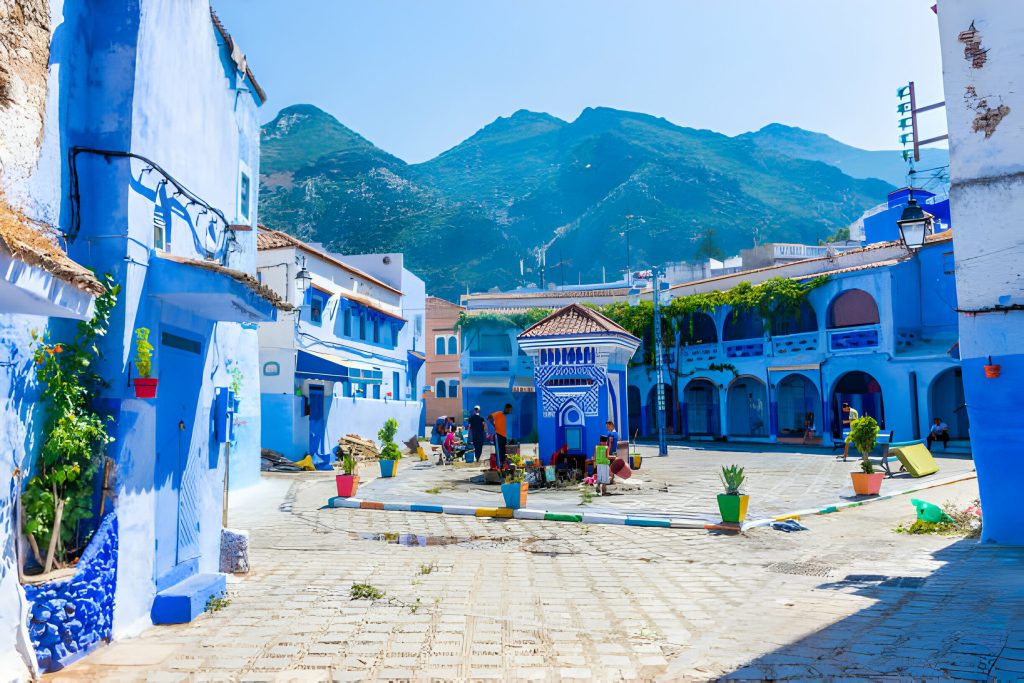
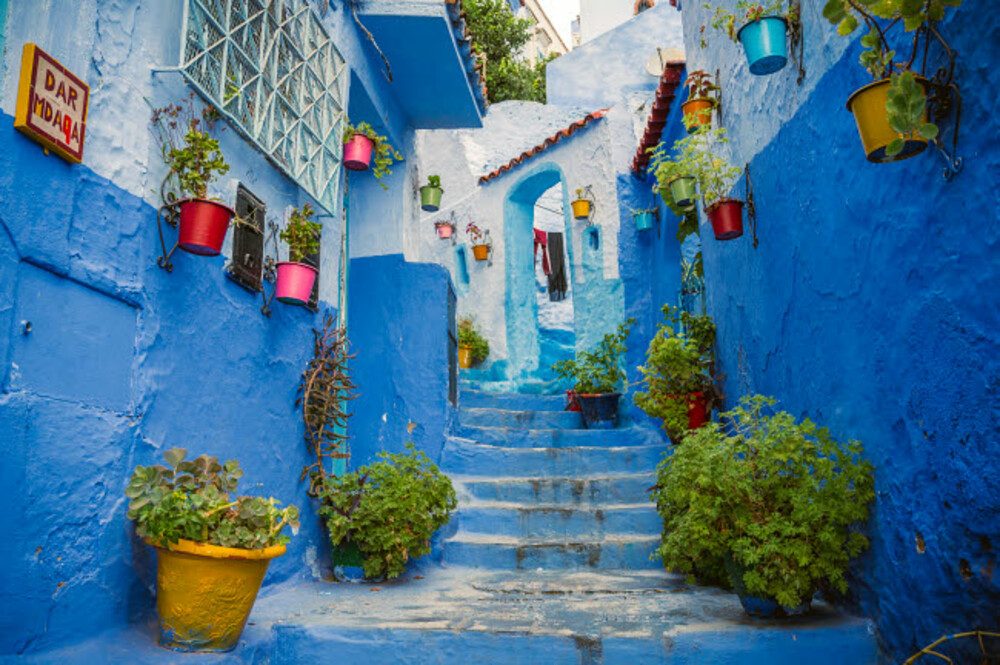
The blue streets
Chefchaouen, known for its striking blue-washed buildings, is a photographer’s dream. Wander through the maze-like streets and enjoy the calming ambiance of this picturesque town. The blue hues, said to symbolize the sky and heaven, create a serene and almost mystical atmosphere. As you explore the narrow alleys and stairways, you’ll find charming shops, cafes, and markets selling local handicrafts. The town’s unique color palette and relaxed vibe make it a must-visit destination for those seeking a blend of beauty and tranquility.
Ras El Maa waterfall
A short walk from the medina, Ras El Maa Waterfall is a refreshing escape. It’s a great spot to relax and take in the natural beauty of the Rif Mountains. The cascading waters provide a cool retreat, and the surrounding area offers plenty of opportunities for hiking and exploration. Local residents often gather here to enjoy picnics or do laundry, adding to the site’s authentic charm. Whether you’re looking to unwind or explore the scenic surroundings, Ras El Maa offers a perfect complement to the vibrant streets of Chefchaouen.
Sahara desert – the golden sands
Camel trekking
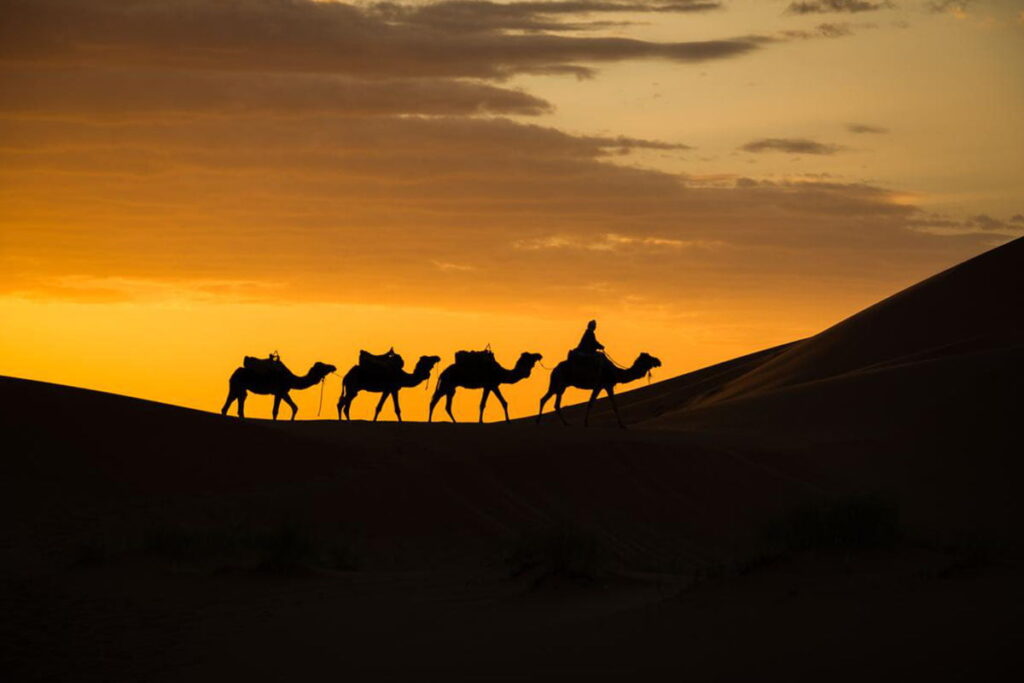
Experience the magic of the Sahara Desert with a camel trek. As you traverse the vast dunes, you’ll feel like you’ve stepped into another world. The slow, rhythmic pace of the camels allows you to fully absorb the breathtaking landscape of rolling sand dunes and endless horizons. Many tours include overnight stays in traditional Berber tents, where you can enjoy a starlit sky and the silence of the desert. Camel trekking in the Sahara offers an unforgettable adventure, connecting you with the timeless beauty and tranquility of this iconic desert.
Erg Chebbi dunes
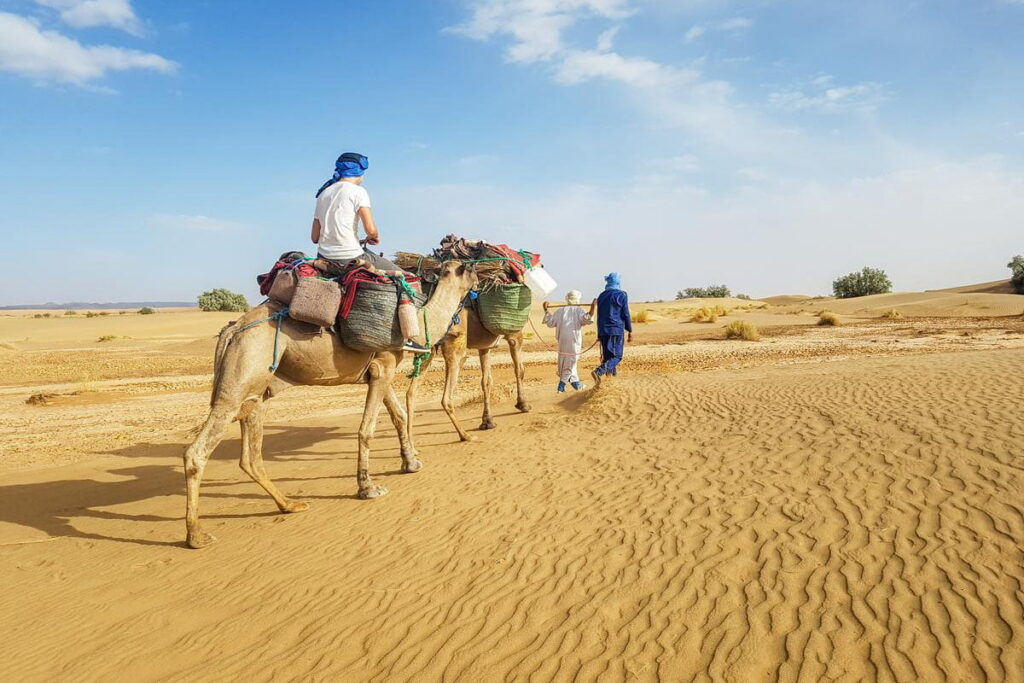
The Erg Chebbi Dunes are some of the highest in Morocco. Watching the sunrise or sunset over these golden sands is a truly awe-inspiring experience. The play of light and shadow across the dunes creates a spectacular natural display, making it a favorite spot for photographers and nature enthusiasts. Visitors can explore the dunes on foot, by camel, or even by sandboarding for a thrilling ride. Erg Chebbi offers a unique opportunity to witness the grandeur of the Sahara and immerse yourself in its serene and majestic landscape.
Essaouira – the coastal gem
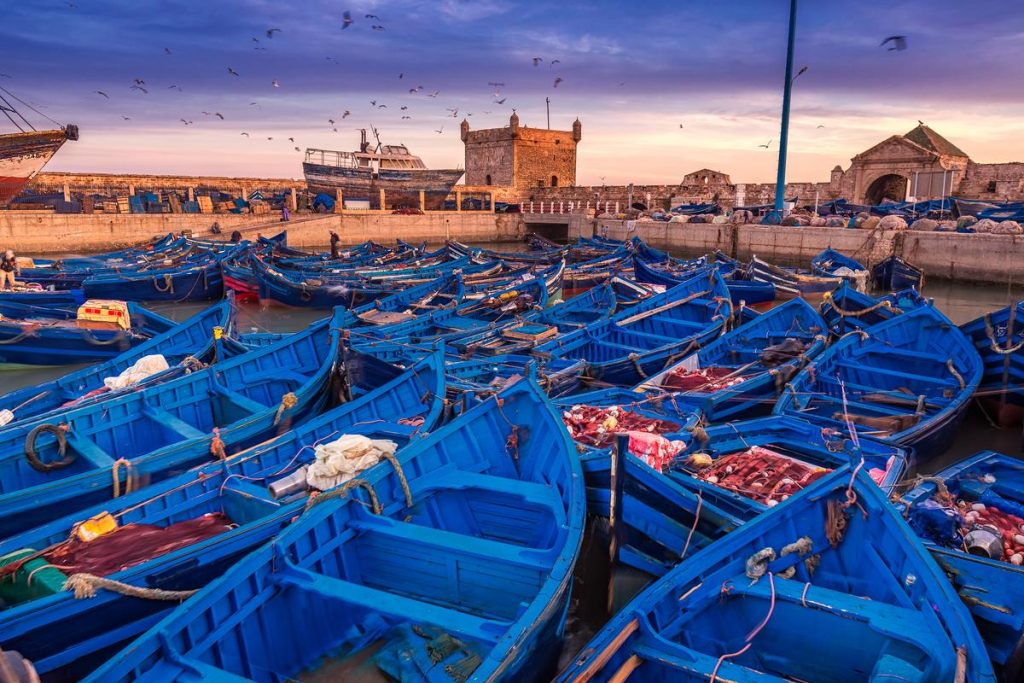
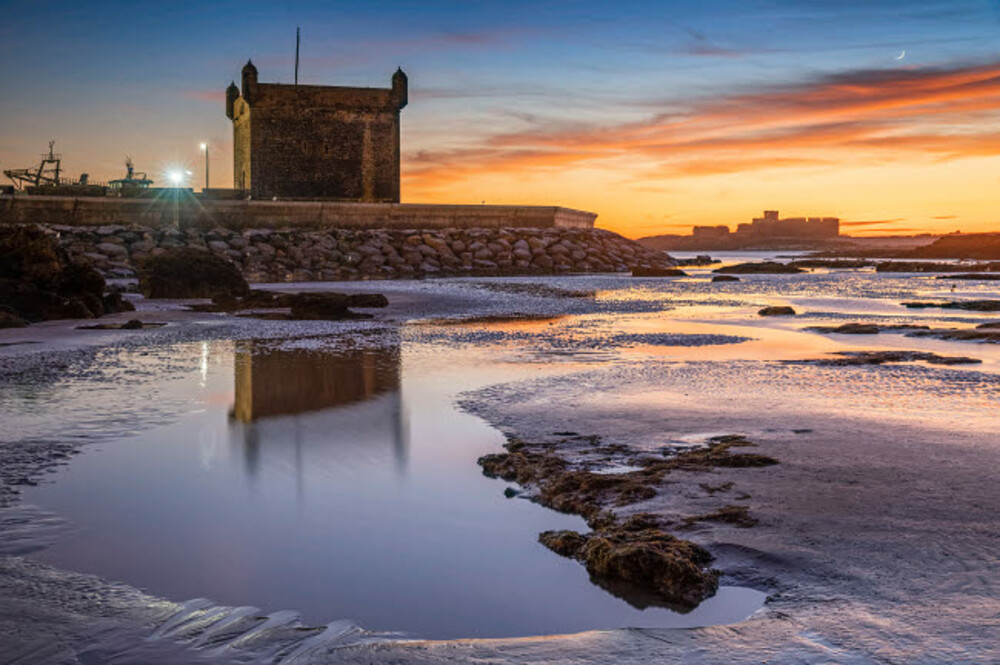
Essaouira citadel
Essaouira’s well-preserved citadel offers stunning views of the Atlantic Ocean. This coastal city is also known for its vibrant arts scene and laid-back vibe. The citadel, with its historic ramparts and cannons, provides a glimpse into the city’s past as a strategic port. Inside the walls, you’ll find bustling markets, art galleries, and music festivals that showcase Essaouira’s cultural richness. The blend of historic architecture and artistic energy makes the citadel a central point for exploring the unique charm of Essaouira.
Moulay Hassan square
The bustling Moulay Hassan Square is the perfect place to enjoy Essaouira’s lively atmosphere. Surrounded by cafes and shops, it’s a great spot to people-watch and soak up the local culture. The square often hosts street performers, musicians, and artists, adding to its vibrant ambiance. Whether you’re sipping a mint tea at a sidewalk cafe or browsing the local markets, Moulay Hassan Square offers a dynamic snapshot of Essaouira’s daily life. It’s an ideal place to relax and immerse yourself in the rhythm of this coastal city.
Rabat – the capital city
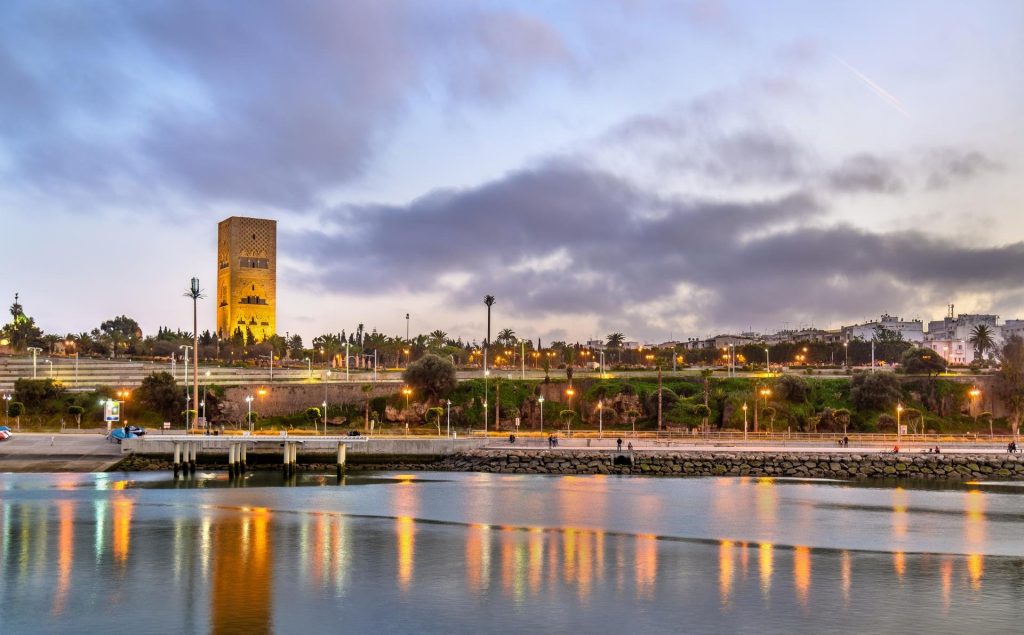
Hassan Tower
Hassan Tower, an unfinished minaret, is a symbol of Rabat’s historical significance. Nearby, the Mausoleum of Mohammed V is a stunning example of traditional Moroccan architecture. The tower, originally intended to be the tallest minaret in the world, stands as a testament to the ambitious vision of its builders. The adjacent mausoleum, with its intricate design and serene atmosphere, honors the royal family and attracts visitors from around the globe. Together, these landmarks offer a profound insight into Rabat’s rich heritage and architectural grandeur.
Kasbah of the Udayas
The Kasbah of the Udayas is a charming fortress with narrow streets, blue and white houses, and beautiful gardens. It offers a peaceful retreat from the city’s hustle. Overlooking the Bou Regreg River, the Kasbah provides stunning views of the surrounding area, including the Atlantic Ocean. Inside, you’ll find a delightful blend of Andalusian and Moroccan architecture, with lush gardens and quaint alleyways to explore. The serene atmosphere and historical significance make the Kasbah of the Udayas a must-visit destination in Rabat.
Casablanca – the modern marvel
Hassan II Mosque
The Hassan II Mosque, one of the largest in the world, is a masterpiece of modern Islamic architecture. Its location on the Atlantic coast adds to its grandeur. The mosque’s towering minaret, intricate mosaics, and vast prayer hall are awe-inspiring, showcasing the best of Moroccan craftsmanship. Visitors can take guided tours to appreciate the architectural details and learn about the mosque’s cultural and religious significance. The Hassan II Mosque stands as a symbol of Casablanca’s blend of tradition and modernity, making it a key highlight of the city.
The corniche
Casablanca’s Corniche is a popular seaside promenade. With its beaches, restaurants, and nightclubs, it’s a great place to unwind and enjoy the ocean views. The area offers a lively mix of entertainment options, from upscale dining to casual beach cafes, catering to both locals and tourists. Walking along the Corniche, you can take in the fresh sea breeze and the stunning coastal scenery. It’s an ideal spot for relaxation and socializing, capturing the vibrant and cosmopolitan spirit of Casablanca.
Meknes – the imperial city
Bab Mansour
Bab Mansour, one of Morocco’s most impressive gates, stands as a testament to Meknes’ imperial past. Its intricate design and grandeur are captivating. Built in the 18th century, this monumental gate features detailed mosaics, carved marble columns, and grand arches. It serves as a striking entrance to the historic medina and reflects the architectural brilliance of the Alaouite dynasty. Bab Mansour’s imposing presence and artistic craftsmanship make it a must-see landmark, offering a glimpse into the glory of Meknes’ imperial history.
Heri es-Souani
Heri es-Souani, the royal granaries and stables, showcases the ingenuity of Moroccan engineering. It’s a fascinating site to explore and learn about Meknes’ history. Built to support Sultan Moulay Ismail’s immense army, these structures feature impressive vaults and a sophisticated water management system. The granaries, with their thick walls and high ceilings, were designed to keep grain cool and dry, ensuring a steady supply for the city. Exploring Heri es-Souani provides a unique insight into the logistical prowess and architectural innovation of the time.
Tangier – the gateway to Africa
The Kasbah museum
Housed in the former Sultan’s palace, the Kasbah Museum offers a rich collection of artifacts that tell the story of Tangier’s diverse history. The museum’s exhibits span various periods, from prehistoric times to the modern era, highlighting Tangier’s role as a cultural crossroads. Visitors can explore rooms filled with traditional crafts, ancient pottery, and historical documents. The palace itself, with its Andalusian-style architecture and lush gardens, adds to the museum’s charm. A visit to the Kasbah Museum provides a comprehensive overview of Tangier’s multifaceted heritage.
Cap spartel
Cap Spartel, where the Atlantic Ocean meets the Mediterranean Sea, offers breathtaking views. It’s a perfect spot for nature lovers and those seeking tranquility. The cape is home to a historic lighthouse, built in 1864, which stands as a sentinel over the converging waters. The surrounding area features lush forests and scenic trails, ideal for hiking and picnicking. Cap Spartel’s dramatic coastal scenery and serene environment make it a popular destination for visitors looking to experience the natural beauty and peaceful ambiance of Tangier.
Ouarzazate – the door of the desert
Ait Benhaddou
Ait Benhaddou, a UNESCO World Heritage site, is an ancient fortified village that has served as a backdrop for many famous films. Its mud-brick buildings are a sight to behold. The ksar, with its traditional Moroccan earthen architecture, offers a fascinating glimpse into the past. Visitors can wander through the narrow streets, climb to the top for panoramic views, and explore the historic kasbahs. Ait Benhaddou’s unique blend of history, culture, and cinematic fame makes it a must-visit location in the Ouarzazate region.
Atlas studios
Known as the “Hollywood of Morocco,” Atlas Studios in Ouarzazate is one of the largest film studios in the world. It’s a must-visit for movie enthusiasts. The studio has hosted numerous productions, from Hollywood blockbusters to historical epics, and offers guided tours that showcase film sets, props, and behind-the-scenes insights. Visitors can explore elaborate sets that recreate ancient cities, desert landscapes, and more. Atlas Studios provides a unique opportunity to see where cinematic magic is made and learn about the film industry’s impact on the region.
Conclusion
Morocco is a land of contrasts and surprises, where ancient history meets modern vibrancy. From the bustling markets of Marrakech to the tranquil sands of the Sahara, each destination offers a unique experience. Whether you’re exploring the blue streets of Chefchaouen or marveling at the grandeur of Hassan II Mosque, Morocco’s charm will leave you enchanted. The country’s rich tapestry of cultures, landscapes, and historical landmarks invites travelers to immerse themselves in its beauty and diversity. So pack your bags and get ready to embark on an unforgettable journey through this magical land.
FAQs
- What is the best time to visit Morocco? The best time to visit Morocco is during the spring (March to May) or fall (September to November) when the weather is mild and pleasant. These seasons offer comfortable temperatures and fewer tourists, making it ideal for exploring the cities and natural landscapes.
- Is Morocco safe for tourists? Yes, Morocco is generally safe for tourists. However, like any travel destination, it’s important to stay aware of your surroundings and follow local guidelines. Petty crimes like pickpocketing can occur, so it’s best to take common precautions.
- What should I wear when visiting Morocco? It’s recommended to dress modestly, especially in rural areas and religious sites. Lightweight and loose-fitting clothing is ideal for the climate. Women might prefer to cover their shoulders and knees, while comfortable walking shoes are recommended for everyone.
- Do I need a visa to visit Morocco? Visa requirements vary by nationality. Many countries have visa-free arrangements with Morocco, allowing stays of up to 90 days. It’s best to check with the Moroccan consulate or your country’s travel advisory for the latest information specific to your nationality.
- What is the local currency in Morocco? The local currency in Morocco is the Moroccan Dirham (MAD). It’s advisable to carry some cash, especially in smaller towns and markets. While ATMs are widely available in cities, having cash is convenient for smaller transactions and in more rural areas.
All Categories
- Actividades en Marruecos
- Adventure
- Aventura
- blog
- blog
- Camping salvaje
- City Tours
- country tours
- Desert tours
- Estilo de vida
- Excursiones de un día a Marrakech
- Life Style
- Marrakech Day Trips
- Morocco activities
- Morocoo
- Rutas por el desierto
- Sin categorizar
- viajes por el país
- Visitas por la ciudad
- Wild Camping

